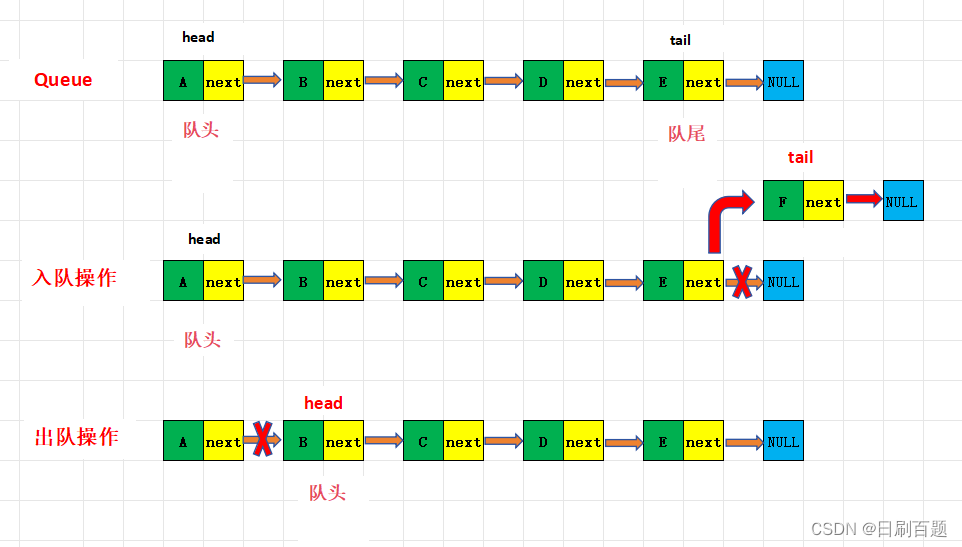数据结构——栈与队列
一、栈
1.1 栈的概念及结构
栈:一种特殊的线性表,其只允许在固定的一端进行插入和删除元素操作。 进行数据插入和删除操作的一端 称为栈顶,另一端称为栈底。 栈中的数据元素遵守后进先出 LIFO ( Last In First Out )的原则。
压栈
:栈的插入操作叫做进栈
/
压栈
/
入栈,
入数据在栈顶。
出栈
:栈的删除操作叫做出栈。
出数据也在栈顶。

1.2 栈的实现(数组栈)
栈的实现一般可以使用
数组或者链表实现
,相对而言数组的结构实现更优一些。因为数组在尾上插入数据的代价比较小。

1.2.1 栈的基本功能实现
#include<stdio.h>
#include<stdbool.h>
#include<assert.h>
typedef int SDateType;
typedef struct Stack
{
SDateType* a;
int top;
int capacity;
}Stack;
//初始化栈和销毁栈
void InitStack(Stack* ps);
void DestoryStack(Stack* ps);
//出栈和入栈
void StackPush(Stack* ps, SDateType x);
void StackPop(Stack* ps);
//栈的有效个数和栈顶元素
int StackSize(Stack* ps);
int StackTop(Stack* ps);
//栈是否为空
bool StackEmpty(Stack* ps);1.2.1.1 栈的初始化和销毁
//初始化栈和销毁栈
void InitStack(Stack* ps)
{
assert(ps);
ps->a = NULL;
ps->capacity = ps->top = 0;
}
void DestoryStack(Stack* ps)
{
assert(ps);
free(ps->a);
ps->a = NULL;
ps->capacity = ps->top = 0;
}1.2.1.2 入栈和出栈
//出栈和入栈
void StackPush(Stack* ps, SDateType x)
{
assert(ps);
//扩容
if (ps->top == ps->capacity)
{
SDateType newcapacity = ps->capacity == 0 ? 4 : ps->capacity * 2;
SDateType* tmp = (SDateType*)realloc(ps->a,newcapacity*sizeof(SDateType));
if (tmp == NULL)
{
perror("realloc fail:");
return;
}
ps->a = tmp;
ps->capacity = newcapacity;
}
//尾插
ps->a[ps->top] = x;
ps->top++;
}
void StackPop(Stack* ps)
{
assert(ps);
assert(ps->top > 0);//只少有一个元素,才能删除
ps->top--;
}
1.2.1.3 栈的元素个数和栈顶元素
//栈的有效个数和栈顶元素
int StackSize(Stack* ps)
{
assert(ps);
return ps->top;
}
int StackTop(Stack* ps)
{
assert(ps);
assert(ps->top > 0);
return ps->a[ps->top - 1];
}
1.2.1.4 栈是否为空
//栈是否为空
bool StackEmpty(Stack* ps)
{
assert(ps);
return ps->top == 0;
}1.2.2 Stack.h
#include<stdio.h>
#include<stdbool.h>
#include<assert.h>
typedef int SDateType;
typedef struct Stack
{
SDateType* a;
int top;
int capacity;
}Stack;
//初始化栈和销毁栈
void InitStack(Stack* ps);
void DestoryStack(Stack* ps);
//出栈和入栈
void StackPush(Stack* ps, SDateType x);
void StackPop(Stack* ps);
//栈的有效个数和栈顶元素
int StackSize(Stack* ps);
int StackTop(Stack* ps);
//栈是否为空
bool StackEmpty(Stack* ps);1.2.3 Stach.c
#include"Stack.h"
//初始化栈和销毁栈
void InitStack(Stack* ps)
{
assert(ps);
ps->a = NULL;
ps->capacity = ps->top = 0;
}
void DestoryStack(Stack* ps)
{
assert(ps);
free(ps->a);
ps->a = NULL;
ps->capacity = ps->top = 0;
}
//出栈和入栈
void StackPush(Stack* ps, SDateType x)
{
assert(ps);
//扩容
if (ps->top == ps->capacity)
{
SDateType newcapacity = ps->capacity == 0 ? 4 : ps->capacity * 2;
SDateType* tmp = (SDateType*)realloc(ps->a,newcapacity*sizeof(SDateType));
if (tmp == NULL)
{
perror("realloc fail:");
return;
}
ps->a = tmp;
ps->capacity = newcapacity;
}
//尾插
ps->a[ps->top] = x;
ps->top++;
}
void StackPop(Stack* ps)
{
assert(ps);
assert(ps->top > 0);//只少有一个元素,才能删除
ps->top--;
}
//栈的有效个数和栈顶元素
int StackSize(Stack* ps)
{
assert(ps);
return ps->top;
}
int StackTop(Stack* ps)
{
assert(ps);
assert(ps->top > 0);
return ps->a[ps->top - 1];
}
//栈是否为空
bool StackEmpty(Stack* ps)
{
assert(ps);
return ps->top == 0;
}二、队列
2.1 队列的概念及结构
队列:只允许在一端进行插入数据操作,在另一端进行删除数据操作的特殊线性表,队列具有先进先出 FIFO(First In First Out)的原则。
入队列:进行插入操作的一端称为队尾
出队列:进行删除操作的一端称为队头
2.2 队列的实现(单链表队列)
队列也可以数组和链表的结构实现,使用链表的结构实现更优一些,因为如果使用数组的结构,出队列在数 组头上出数据,效率会比较低。

2.2.1 队列的基本功能实现
#include<stdio.h>
#include<stdbool.h>
#include<stdlib.h>
#include<assert.h>
typedef int QDateType;
typedef struct QueueNode
{
QDateType val;
struct QueueNode * next;
}QueueNode;
typedef struct Queue
{
QueueNode *head;
QueueNode *tail;
QDateType size;
}Queue;
// 初始化队列
void QueueInit(Queue* pq);
void QueueDestroy(Queue* pq);
// 队尾入列和出列
void QueuePush(Queue* pq, QDateType x);
void QueuePop(Queue* pq);
// 返回队头和队尾
QDateType QueueFront(Queue* pq);
QDateType QueueBack(Queue* pq);
// 获取队列中有效元素个数
int QueueSize(Queue* pq);
// 检测队列是否为空
bool QueueEmpty(Queue* pq);
2.2.1.1 队列的初始化和销毁
// 初始化队列
void QueueInit(Queue* pq)
{
assert(pq);
pq->head = pq->tail = NULL;
pq->size = 0;
}
//队列的销毁
bool QueueEmpty(Queue* pq)
{
assert(pq);
return pq->head==NULL;
}2.2.1.2 入列和出列
//入列
void QueuePush(Queue* pq, QDateType x)
{
assert(pq);
QueueNode* node = (QueueNode*)malloc(sizeof(QueueNode));
node->val = x;
node->next = NULL;
if (pq->tail == NULL)
{
pq->head = pq->tail = node;
pq->size++;
}
else
{
pq->tail->next = node;
pq->tail = node;
pq->size++;
}
}
//出列
void QueuePop(Queue* pq)
{
assert(pq);
assert(pq->head != NULL);//只少保证一个节点
QueueNode* del = pq->head;
pq->head = pq->head->next;
free(del);
del = NULL;
pq->size--;
if (pq->head == NULL)//只有一个节点处理
{
pq->tail = NULL;
}
}2.2.1.3 返回队头和队尾元素
// 返回队头和队尾
QDateType QueueFront(Queue* pq)
{
assert(pq);
return pq->head->val;
}
QDateType QueueBack(Queue* pq)
{
assert(pq);
return pq->tail->val;
}2.2.1.4 队列元素个数
// 获取队列中有效元素个数
int QueueSize(Queue* pq)
{
assert(pq);
return pq->size;
}2.2.1.5 队列是否为空
bool QueueEmpty(Queue* pq)
{
assert(pq);
return pq->head==NULL;
}
2.2.2 Queue.h
#include<stdio.h>
#include<stdbool.h>
#include<stdlib.h>
#include<assert.h>
typedef int QDateType;
typedef struct QueueNode
{
QDateType val;
struct QueueNode * next;
}QueueNode;
typedef struct Queue
{
QueueNode *head;
QueueNode *tail;
QDateType size;
}Queue;
// 初始化队列
void QueueInit(Queue* pq);
void QueueDestroy(Queue* pq);
// 队尾入列和出列
void QueuePush(Queue* pq, QDateType x);
void QueuePop(Queue* pq);
// 返回队头和队尾
QDateType QueueFront(Queue* pq);
QDateType QueueBack(Queue* pq);
// 获取队列中有效元素个数
int QueueSize(Queue* pq);
// 检测队列是否为空
bool QueueEmpty(Queue* pq);
2.2.1 Queue.c
#include"Queue.h"
// 初始化队列
void QueueInit(Queue* pq)
{
assert(pq);
pq->head = pq->tail = NULL;
pq->size = 0;
}
void QueuePush(Queue* pq, QDateType x)
{
assert(pq);
QueueNode* node = (QueueNode*)malloc(sizeof(QueueNode));
node->val = x;
node->next = NULL;
if (pq->tail == NULL)
{
pq->head = pq->tail = node;
pq->size++;
}
else
{
pq->tail->next = node;
pq->tail = node;
pq->size++;
}
}
void QueuePop(Queue* pq)
{
assert(pq);
assert(pq->head != NULL);//只少保证一个节点
QueueNode* del = pq->head;
pq->head = pq->head->next;
free(del);
del = NULL;
pq->size--;
if (pq->head == NULL)//只有一个节点处理
{
pq->tail = NULL;
}
}
// 返回队头和队尾
QDateType QueueFront(Queue* pq)
{
assert(pq);
return pq->head->val;
}
QDateType QueueBack(Queue* pq)
{
assert(pq);
return pq->tail->val;
}
// 获取队列中有效元素个数
int QueueSize(Queue* pq)
{
assert(pq);
return pq->size;
}
bool QueueEmpty(Queue* pq)
{
assert(pq);
return pq->head==NULL;
}
void QueueDestroy(Queue* pq)
{
assert(pq);
QueueNode* cur = pq->head;
while (cur)
{
QueueNode* next = cur->next;
free(cur);
cur = next;
}
pq->head = pq->tail = NULL;
pq->size = 0;
}